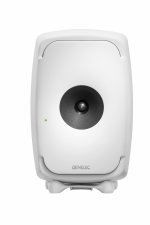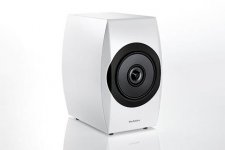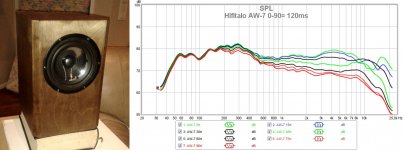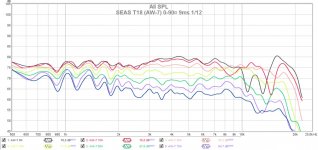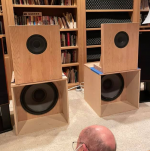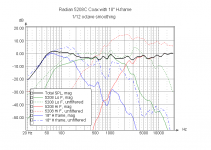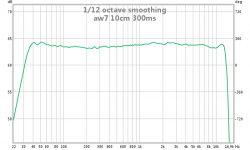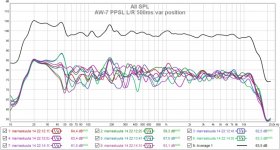Looking at current offerings by reputable manufacturers, 18sound, FaitalPro, etc.
Most if not all good sized coaxials, 12" 15", even 10" seem to have ugly behaviour in the FR at the upper range of the woofer, where it needs to cross to the CD.
Has anyone any idea, done any research, what is it that contributes to this ragged response in the upper range? It seems to be consistent. A sharp dip, and then some ugly peaks.
Is it the horn mouth opening and expansion in the center?
The deep cone profile?
What the heck?
Why can't they make it right, there seems to be an inherent issue...
Most if not all good sized coaxials, 12" 15", even 10" seem to have ugly behaviour in the FR at the upper range of the woofer, where it needs to cross to the CD.
Has anyone any idea, done any research, what is it that contributes to this ragged response in the upper range? It seems to be consistent. A sharp dip, and then some ugly peaks.
Is it the horn mouth opening and expansion in the center?
The deep cone profile?
What the heck?
Why can't they make it right, there seems to be an inherent issue...
Deep cone mostly; notice the Altec/GPA's mod to its 515 woofer's deep curvilinear cone along with earlier Altec 604s with otherwise the same basic 515 cone: http://greatplainsaudio.com/wp-content/uploads/2020/604E/604E_Series_II.pdf
Altec Lansing 604E Coax Speakers (2) with crossover circuits | eBay
http://www.lansingheritage.org/images/altec/specs/components/604-8k/page01.jpg
Altec Lansing 604E Coax Speakers (2) with crossover circuits | eBay
http://www.lansingheritage.org/images/altec/specs/components/604-8k/page01.jpg
I've have noticed modern manufacturing is creeping in. Few "recent" home/studio speakers attached and there might be more. No idea when proaudio scene does something new in this regard.
Attachments
Last edited:
To each advantage you have to take a compromise in a different category. Some things are even mutually exclusive. I.e the tweeter 'wants' a flat baffle with rounded or beveled edges. The mid-woofer wants a more or less rigid cone, which is usually given by its shape and material. A cone is not flat, so you have to decide if you want to make the tweeter happy or the mid-bass. Oh, you want both? Too bad, everyone gets only half - more or less.
The mid-bass should have a relatively light cone, so the VC should not have a big, heavy voice coil. The smaller VC only allows a small tweeter, which needs a high crossover frequency. But the cone got resonances there and beams. Well, sh*t. Okay, then let's put a horn in the middle of the cone. The tweeter can go lower, gains a few db.
Tweeter: "YAY!"
Mid-bass: "Uh, no. My mid gets reflected on the horn! Can't you use my pole core as a horn? My membrane even extends your horn!"
Tweeter: "Maybe? But your cone modulates and changes the sound if you make excursions!"
On the bass/mid you don't have a pole core bore because there is the tweeter. The coax doesn't have a dust cap, which lessens the problem with the compressed air under it but there's still air which becomes compressed behind the voice coil. On many membranes the dustcap stabilizes the membrane (hard material) or dampens resonances (soft dustcap). Both not possible because of the tweeter.
There are solutions which lessens the one or other problem but it always comes at a price. The tweeter 'on a pole' got a round 'baffle' (its own edge), which is the worst because it gives the strongest baffle step possible, often can't get compensated -> no flat response, even difficult on a DSP. Some tweeters got an odd shaped (non-symmetrical) form, which helps but gets more reflections. Other drivers have the tweeter off-center, often with a mounting bridge or mounted on the grill. That's often a good solution but that of course makes the dispersion asymmetrical.
The best sounding coaxials often use exotic solutions and are often very expensive. The best coax I've heard so far was a Cabasse Triax (3 drivers coax), with subs, an immensely expensive chain (well in the 6-figures).
Technics had the RX-50 and RX-30 coaxial speakers in the 80s, they sound excellent, very good dispersion because of the flat membrane drivers. I always wanted to buy these, when I had the money there were none available and vice versa. 🙁
The THIEL-AUDIO SCS-3N MkII are excellent, almost flat cone, expensive (~500€). You can read a test with measurements here (German).
KEF got very good coax drivers, you can order them from Boutique Haut-parleurs & Audio DIY
There are many possible solutions and it does not always have to be expensive, you can build a coax from normal drivers but it's often a lot of effort because trail and error. Generally, it's a lot better to design them not to on-axis, the coax speakers often get more linear and easier to handle at ~10-15° off axis.
The mid-bass should have a relatively light cone, so the VC should not have a big, heavy voice coil. The smaller VC only allows a small tweeter, which needs a high crossover frequency. But the cone got resonances there and beams. Well, sh*t. Okay, then let's put a horn in the middle of the cone. The tweeter can go lower, gains a few db.
Tweeter: "YAY!"
Mid-bass: "Uh, no. My mid gets reflected on the horn! Can't you use my pole core as a horn? My membrane even extends your horn!"
Tweeter: "Maybe? But your cone modulates and changes the sound if you make excursions!"
On the bass/mid you don't have a pole core bore because there is the tweeter. The coax doesn't have a dust cap, which lessens the problem with the compressed air under it but there's still air which becomes compressed behind the voice coil. On many membranes the dustcap stabilizes the membrane (hard material) or dampens resonances (soft dustcap). Both not possible because of the tweeter.
There are solutions which lessens the one or other problem but it always comes at a price. The tweeter 'on a pole' got a round 'baffle' (its own edge), which is the worst because it gives the strongest baffle step possible, often can't get compensated -> no flat response, even difficult on a DSP. Some tweeters got an odd shaped (non-symmetrical) form, which helps but gets more reflections. Other drivers have the tweeter off-center, often with a mounting bridge or mounted on the grill. That's often a good solution but that of course makes the dispersion asymmetrical.
The best sounding coaxials often use exotic solutions and are often very expensive. The best coax I've heard so far was a Cabasse Triax (3 drivers coax), with subs, an immensely expensive chain (well in the 6-figures).
Technics had the RX-50 and RX-30 coaxial speakers in the 80s, they sound excellent, very good dispersion because of the flat membrane drivers. I always wanted to buy these, when I had the money there were none available and vice versa. 🙁
The THIEL-AUDIO SCS-3N MkII are excellent, almost flat cone, expensive (~500€). You can read a test with measurements here (German).
KEF got very good coax drivers, you can order them from Boutique Haut-parleurs & Audio DIY
There are many possible solutions and it does not always have to be expensive, you can build a coax from normal drivers but it's often a lot of effort because trail and error. Generally, it's a lot better to design them not to on-axis, the coax speakers often get more linear and easier to handle at ~10-15° off axis.
Last edited:
I wouldn't lose much sleep over it. Perfection is never attained. 😀
Forum member Mike Chua has thoroughly investigated Eminence CX coaxials with Selenium D220ti compression drivers.
Osprey-II Revisited (Eminence 10CX with Selenium D220ti) – AmpsLab
As a good engineer, he just does the best he can. Quite a good result in his various takes on the Osprey speaker.
Forum member Mike Chua has thoroughly investigated Eminence CX coaxials with Selenium D220ti compression drivers.
Osprey-II Revisited (Eminence 10CX with Selenium D220ti) – AmpsLab
As a good engineer, he just does the best he can. Quite a good result in his various takes on the Osprey speaker.
The best coax I've heard so far was a Cabasse Triax (3 drivers coax)
I have heard it too and I agree.
I haven't had much success with co-axials. I would like to try the new SEAS ones some day...and BMS...
Last edited:
The problems described in post #1 come from the interferences caused by the diameter of a circular cone. Same thing plaques the on-axis response of any horn/waveguide tweeter depending on exit/driver diameter, at around 12-15khz.
https://www.klippel.de/fileadmin/_migrated/content_uploads/KLIPPEL_Sound_Radiation_Poster_01.pdf
So, best coaxial "smoothness" can be realized only with less than 10" woofers. Which will easily lead to a 3-way construction or one must have a subwoofer at least.
A 15" coax with xo directivity Coaxial speaker Beyma 15XA38Nd, 8+16 ohm, 15 inch
"Problem" is not as bad as it looks, when we look at power response that sums on- and off-axis. Same smoothing happens when we listen to the speaker, preferably at 10-15deg off-axis to avoid the most exaggerated wiggles happening directly on-axis.
SEAS 6½" coaxial datasheet shows off-axis responses for the woofer and the tweeter. Pro diver datasheets typically show only on-axis response, sadly.
Coaxial speaker SEAS C18EN002/A, 8+6 ohm, 6.9 inch
https://www.klippel.de/fileadmin/_migrated/content_uploads/KLIPPEL_Sound_Radiation_Poster_01.pdf
So, best coaxial "smoothness" can be realized only with less than 10" woofers. Which will easily lead to a 3-way construction or one must have a subwoofer at least.
A 15" coax with xo directivity Coaxial speaker Beyma 15XA38Nd, 8+16 ohm, 15 inch
"Problem" is not as bad as it looks, when we look at power response that sums on- and off-axis. Same smoothing happens when we listen to the speaker, preferably at 10-15deg off-axis to avoid the most exaggerated wiggles happening directly on-axis.
SEAS 6½" coaxial datasheet shows off-axis responses for the woofer and the tweeter. Pro diver datasheets typically show only on-axis response, sadly.
Coaxial speaker SEAS C18EN002/A, 8+6 ohm, 6.9 inch
To each advantage you have to take a compromise in a different category. Some things are even mutually exclusive. I.e the tweeter 'wants' a flat baffle with rounded or beveled edges. The mid-woofer wants a more or less rigid cone, which is usually given by its shape and material. A cone is not flat, so you have to decide if you want to make the tweeter happy or the mid-bass. Oh, you want both? Too bad, everyone gets only half - more or less.
So true, so true. I personally do not see the advantages of a coax as overcoming the disadvantages pointed out by ICG. But I am open to being persuaded otherwise.
Imagine we compare a coax system and a conventional vertically aligned system using the same drivers (and all else being equal). The horizontal polar response will be virtually the same, and in theory it could be exactly the same if "all else" is truly equal. It is only in the vertical polar responses that the coax will be different. The coax has the potential to have a better vertical polar response... Does this advantage outweigh the negatives? As I said, I am not convinced.
j.
Hi,
Hifijim, i bet you never had a 'good' one at home for extended period.
The situation you describe is what i have @ home atm: a 'big' 15"+ 4" +1" ( Technics Sb-M1) dsp processed and a 8" coax ( Tannoy System800).
Both have their strength and weakness. The coax being very different in rendering about stereo but not only.
I prefer it, but'll try to 'cure' ( mitigate) issues a 2way bring and @same time mitigate modulation through direct driver cone with my next. And i'll trade the ragged response ( which is still here in the Tannoy's 8" anyway... and is a non issue once you use them 15* off axis imho) for a better lower directivity control ( will go higher diameter at least 12").
I'm less disturbed by the ragged response than the lack of coincident / point sourceness coherency AND the ( more or less) smoother controled polar behavior.
A matter of preferences . But still it have to be experienced, not trying to unset your mind bias.
Theory won't tell you if it works for you or not ( i've seen people unable to work on Tannoy's when in studio... people too much used to the distortion more 'classical' lay out arrangement brings). Experience it will.
Hifijim, i bet you never had a 'good' one at home for extended period.
The situation you describe is what i have @ home atm: a 'big' 15"+ 4" +1" ( Technics Sb-M1) dsp processed and a 8" coax ( Tannoy System800).
Both have their strength and weakness. The coax being very different in rendering about stereo but not only.
I prefer it, but'll try to 'cure' ( mitigate) issues a 2way bring and @same time mitigate modulation through direct driver cone with my next. And i'll trade the ragged response ( which is still here in the Tannoy's 8" anyway... and is a non issue once you use them 15* off axis imho) for a better lower directivity control ( will go higher diameter at least 12").
I'm less disturbed by the ragged response than the lack of coincident / point sourceness coherency AND the ( more or less) smoother controled polar behavior.
A matter of preferences . But still it have to be experienced, not trying to unset your mind bias.
Theory won't tell you if it works for you or not ( i've seen people unable to work on Tannoy's when in studio... people too much used to the distortion more 'classical' lay out arrangement brings). Experience it will.
Last edited:
The best large 2-way coaxial that I've heard is Martion Bullfrog Active. It has a large horn with extra flange for the compression driver, and a funny red phase-plug. It's 2-way dsp controlled, 680Hz xo and amps in a box.
Bullfrog active | Martion

And we Finns have many popular kit coaxial with SEAS or B&C drivers. I have made 5 SEAS T18 based 2-ways for my home theater, and I must say that the L/C/R combo gives best imaging for movies that I have had. Measured response, indoors gated 120ms and 1/6 smoothed. And at 1m 9ms 1/12 smoothing. Gradient was first "big name" before Genelec, to use coaxial mid-tweeter units.
Bullfrog active | Martion

And we Finns have many popular kit coaxial with SEAS or B&C drivers. I have made 5 SEAS T18 based 2-ways for my home theater, and I must say that the L/C/R combo gives best imaging for movies that I have had. Measured response, indoors gated 120ms and 1/6 smoothed. And at 1m 9ms 1/12 smoothing. Gradient was first "big name" before Genelec, to use coaxial mid-tweeter units.
Last edited:
Hifijim, i bet you never had a 'good' one at home for extended period.
I bet you are right... It has been 20+ years since I seriously listened to a good coax, it was in the home recording studio of a professional musician, it was a 12" or 15" with a horn compression driver. The horn was rectangular bi-radial type IRRC...
So my opinion is not based on experience of any kind.
I'm not telling you you have not experience, i'm telling our mind biasing make us expect things, only a real comparison can give a definitive answer to your preference ( and at the time you do it. This is suceptible to change too).
I've worked with coax without never really get why people was into them ( except for the system15mk2).
Then i used some at home in a much more complicated acoustic and in direct comparison to my own 3way 'reference monitor'.
The differences was much more obvious and for 2 years now they not really changed since* ( even if i downsized from 12"( wasn't mine, they had to go back) ) to 8").
I've not spent many times with Altecs/urei. This side of Atlantic we find Tannoy much often so can't tell about a comparison between them.
Was reluctant to the principle of using a horn in a coax because of diffraction issues. Was prooved to be wrong about it when i heard Presonus Sceptre ( but they use FIR from Fulcrum Acoustics to compensate diffraction issues). They are on par with the one i liked the most.
* i'm convinced i can't make reliable judgement short term. This is interesting and give infos but only long period of exposure to gear will give a real judgement of quality.
I've worked with coax without never really get why people was into them ( except for the system15mk2).
Then i used some at home in a much more complicated acoustic and in direct comparison to my own 3way 'reference monitor'.
The differences was much more obvious and for 2 years now they not really changed since* ( even if i downsized from 12"( wasn't mine, they had to go back) ) to 8").
I've not spent many times with Altecs/urei. This side of Atlantic we find Tannoy much often so can't tell about a comparison between them.
Was reluctant to the principle of using a horn in a coax because of diffraction issues. Was prooved to be wrong about it when i heard Presonus Sceptre ( but they use FIR from Fulcrum Acoustics to compensate diffraction issues). They are on par with the one i liked the most.
* i'm convinced i can't make reliable judgement short term. This is interesting and give infos but only long period of exposure to gear will give a real judgement of quality.
Last edited:
SEAS T18 coaxial in closed box
Uhm, the hunch from 140-500Hz is very dominant, that's 5dB!
The 30° (the first black one) measurement looks the best, quite linear.
coax such as this cast frame Eminence 12CX which use a spider-dust shield between the woofer's cone and tweeter horn, usually benefit from a disk of felt or foam over the little spider as it emits junk from 5KHz up


I recently completed an open baffle project using the Radian 8" 5208C coax, along with an 18" H-frame to extend the bass. Overall sound is quite good.So, best coaxial "smoothness" can be realized only with less than 10" woofers. Which will easily lead to a 3-way construction or one must have a subwoofer at least.
It took a fairly extensive (passive) crossover to tame the raw driver responses, but the end result has excellent phase alignment through the crossover regions.
More of the gory details can be found on posts 79 and 80 on this thread:
Radian 5208c coaxial project
Radian 5208c coaxial project
Attachments
Uhm, the hunch from 140-500Hz is very dominant, that's 5dB!
The 30° (the first black one) measurement looks the best, quite linear.
That measurement was done with a very poor mic. Hump in bass is an artefact, but you could see the speaker. Some better indoor measurements here. It is a kit speaker, Hifitalo AW-7 and I use minidsp 2x4HD to EQ it and highpass LR2@90Hz to a 2x15" closed box subwoofer (third measurement).
Attachments
Last edited:
I don't think that's a 12CX - or at least not one that's been made for a number of years.coax such as this cast frame Eminence 12CX which use a spider-dust shield between the woofer's cone and tweeter horn, usually benefit from a disk of felt or foam over the little spider as it emits junk from 5KHz up
After experiencing the various options I settled on coaxials. I was initially put off by the non-flat response. The benefits seem to outweigh the disadvantages. I have experienced Altec 604 and Tannoys. Now I have System 800, Saturn, Sensys and vintage Eaton. The tweeter wave guides help. The best sounding is the Eaton. The System 800 and Saturn had garbage crossovers and had to be redesigned. The drivers are not easy to control.
Overall the main benefit of the Eaton and Sensys is lower phase shift in the midrange. The tweeter at the rear compensates considerably for the phase shift that the crossover introduces. The inherently better time alignment gives a more natural rendition and it is easy to hear with voices. Each model has to be considered on its own merits. I don't rate System 800 or the Saturn, both 8 inch, very highly. I do wish I had tried coaxials much earlier. The Radians seem to have good potential.
Overall the main benefit of the Eaton and Sensys is lower phase shift in the midrange. The tweeter at the rear compensates considerably for the phase shift that the crossover introduces. The inherently better time alignment gives a more natural rendition and it is easy to hear with voices. Each model has to be considered on its own merits. I don't rate System 800 or the Saturn, both 8 inch, very highly. I do wish I had tried coaxials much earlier. The Radians seem to have good potential.
coax such as this cast frame Eminence 12CX which use a spider-dust shield between the woofer's cone and tweeter horn, usually benefit from a disk of felt or foam over the little spider as it emits junk from 5KHz up
I don't think that's a 12CX - or at least not one that's been made for a number of years.
It actually is an Eminence -> Audioasylum
These were also sold under other brand names (with some modifications).
That measurement was done with a very poor mic. Hump in bass is an artefact, but you could see the speaker. Some better indoor measurements here. It is a kit speaker, Hifitalo AW-7 and I use minidsp 2x4HD to EQ it and highpass LR2@90Hz to a 2x15" closed box subwoofer (third measurement).
Ah, thanks for the information. It was probably the room influence then.
- Home
- Loudspeakers
- Multi-Way
- A problem that plagues most coaxials
